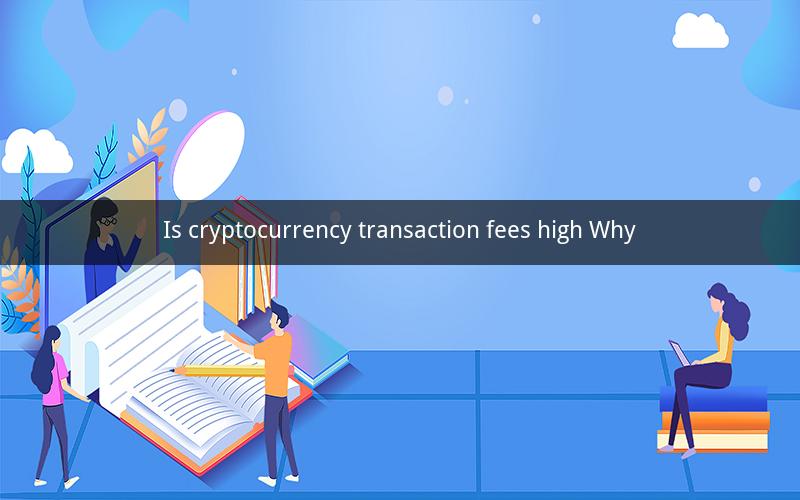
Directory
1. Introduction to Cryptocurrency Transaction Fees
2. Factors Influencing Cryptocurrency Transaction Fees
3. Comparing Cryptocurrency Transaction Fees with Traditional Banking Fees
4. The Impact of High Transaction Fees on Cryptocurrency Users
5. Solutions to High Cryptocurrency Transaction Fees
6. The Future of Cryptocurrency Transaction Fees
7. Conclusion
1. Introduction to Cryptocurrency Transaction Fees
Cryptocurrency transaction fees refer to the costs associated with transferring digital currencies from one address to another. These fees are crucial for maintaining the network's integrity and ensuring secure transactions. However, many users often question whether these fees are high or not.
2. Factors Influencing Cryptocurrency Transaction Fees
Several factors influence the cost of cryptocurrency transaction fees. Understanding these factors can help users make informed decisions about their transactions.
2.1 Network Congestion
Network congestion is one of the primary factors affecting transaction fees. When the network is experiencing high activity, more users are trying to send transactions simultaneously. This increased demand leads to higher fees as miners prioritize transactions with higher fees to confirm them faster.
2.2 Block Size and Block Time
The block size and block time also play a significant role in determining transaction fees. A smaller block size and longer block time result in higher fees, as miners have to wait longer to fill a block with transactions.
2.3 Transaction Complexity
The complexity of a transaction can impact its fee. Transactions with more inputs and outputs require more computational resources, leading to higher fees.
2.4 Transaction Priority
Miners prioritize transactions with higher fees to confirm them faster. Users can increase their transaction priority by paying higher fees.
3. Comparing Cryptocurrency Transaction Fees with Traditional Banking Fees
Comparing cryptocurrency transaction fees with traditional banking fees can provide some insights into their cost-effectiveness.
3.1 Traditional Banking Fees
Traditional banking fees vary depending on the service and the bank. Some common fees include monthly maintenance fees, ATM withdrawal fees, and wire transfer fees. These fees can be higher than cryptocurrency transaction fees, especially for international transfers.
3.2 Cryptocurrency Transaction Fees
Cryptocurrency transaction fees are generally lower than traditional banking fees. This is because they are not subject to the same regulatory and operational costs as traditional banks. Moreover, cryptocurrency transactions are often faster and more transparent.
4. The Impact of High Transaction Fees on Cryptocurrency Users
High transaction fees can have several negative impacts on cryptocurrency users.
4.1 Reduced Accessibility
High fees can deter new users from entering the cryptocurrency market, as they may find it too expensive to transfer small amounts of digital currencies.
4.2 Impaired Scalability
High transaction fees can hinder the scalability of cryptocurrency networks. As more users join the network, the demand for transactions increases, leading to higher fees and potentially causing the network to become less accessible.
4.3 Negative User Experience
High transaction fees can lead to a negative user experience, as users may feel frustrated with the high costs associated with transferring their digital currencies.
5. Solutions to High Cryptocurrency Transaction Fees
Several solutions have been proposed to address high cryptocurrency transaction fees.
5.1 Increase Block Size
Increasing the block size can accommodate more transactions per block, reducing network congestion and lowering fees.
5.2 Implementing Scalability Solutions
Scalability solutions like the Lightning Network and sidechains can help offload transactions from the main blockchain, reducing fees and improving transaction speeds.
5.3 Dynamic Fees
Dynamic fees adjust the fee amount based on network congestion, ensuring that users only pay what is necessary for their transaction.
6. The Future of Cryptocurrency Transaction Fees
The future of cryptocurrency transaction fees remains uncertain. However, several trends and technological advancements may influence their direction.
6.1 Increased Adoption
As cryptocurrency adoption grows, network congestion may decrease, leading to lower transaction fees.
6.2 Technological Advancements
Technological advancements, such as improved scalability solutions and increased block sizes, may help reduce fees in the long term.
6.3 Regulatory Changes
Regulatory changes could impact the cost of cryptocurrency transactions, either by imposing additional fees or by facilitating cheaper transactions.
7. Conclusion
Cryptocurrency transaction fees are a complex issue with various factors influencing their cost. While high fees can be a concern, several solutions and trends suggest that transaction fees may decrease in the future. Understanding the factors that affect fees can help users make informed decisions about their cryptocurrency transactions.
Questions and Answers
1. What are cryptocurrency transaction fees?
Answer: Cryptocurrency transaction fees are the costs associated with transferring digital currencies from one address to another.
2. What factors influence cryptocurrency transaction fees?
Answer: Factors influencing fees include network congestion, block size and block time, transaction complexity, and transaction priority.
3. Are cryptocurrency transaction fees higher than traditional banking fees?
Answer: Generally, cryptocurrency transaction fees are lower than traditional banking fees, especially for international transfers.
4. How can high transaction fees impact cryptocurrency users?
Answer: High fees can deter new users, hinder scalability, and lead to a negative user experience.
5. What are some solutions to high cryptocurrency transaction fees?
Answer: Solutions include increasing block size, implementing scalability solutions, and using dynamic fees.
6. How might the future of cryptocurrency transaction fees look?
Answer: The future of fees may be influenced by increased adoption, technological advancements, and regulatory changes.
7. Can increasing the block size reduce cryptocurrency transaction fees?
Answer: Yes, increasing the block size can accommodate more transactions, potentially reducing fees.
8. What is the Lightning Network, and how does it impact transaction fees?
Answer: The Lightning Network is a scalability solution that allows off-chain transactions, reducing fees and improving transaction speeds.
9. How can dynamic fees help reduce cryptocurrency transaction fees?
Answer: Dynamic fees adjust the fee amount based on network congestion, ensuring that users only pay what is necessary for their transaction.
10. Are there any regulatory changes that could impact cryptocurrency transaction fees?
Answer: Yes, regulatory changes could impose additional fees or facilitate cheaper transactions, influencing the cost of cryptocurrency transactions.